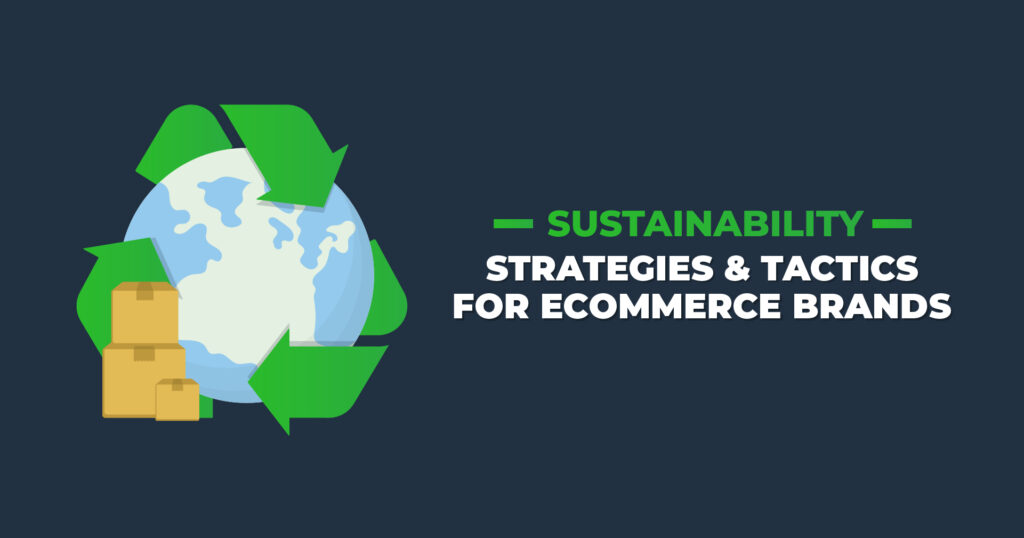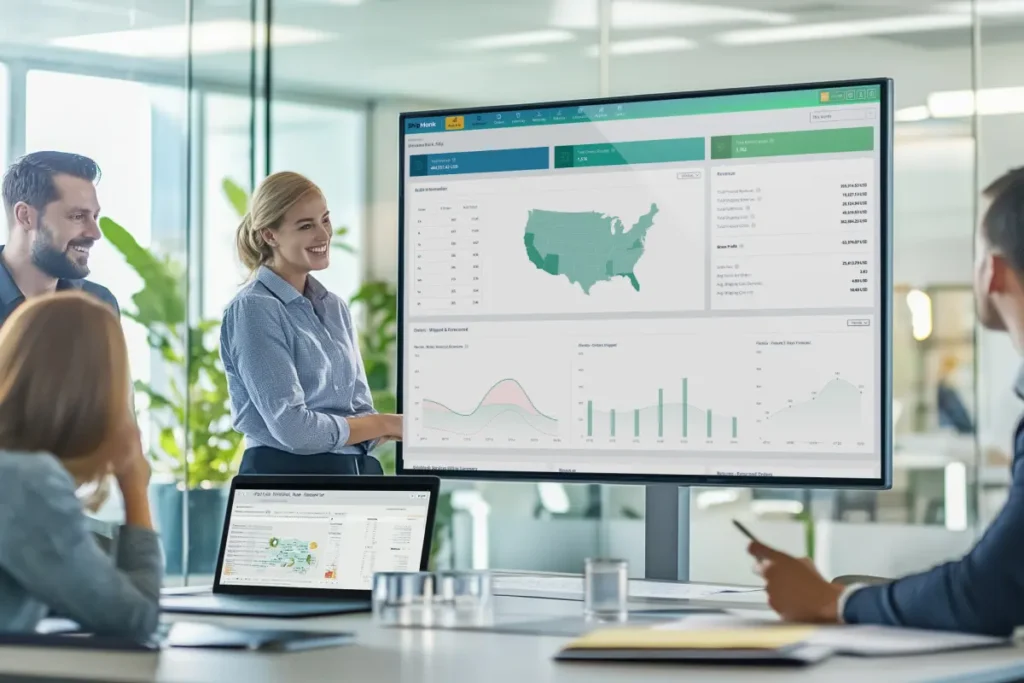We all want to be one of the cool kids — you know, the sustainable brands that are always doing the right thing and always look great while doing it. Trouble is, managing an ecommerce brand involves certain unavoidable carbon-causing activities like packaging, shipping and returns. So, what can you do to make your brand more sustainable, and where do you start? That’s what we’re going to cover today.
What Does Sustainability Mean?
The UN World Commission on Environment and Development defines sustainability as “development that meets the needs of the present without compromising the ability of future generations to meet their own needs.” In other words, businesses that leave the world better than (or at least the same as) they found it.
In the ecommerce world, sustainability mainly comes down to three things:
- reducing the non-renewable resources your business uses
- reducing greenhouse gasses that add to climate change
- reducing waste from packaging and unsold or returned inventory that ends up in landfills
Manufacturing, shipping, fulfillment services, and running an office are all activities that contribute to your ecommerce business’ carbon footprint. While it is impossible to completely eliminate your carbon footprint (you are shipping packages daily, after all), you can offset the negative impacts with positive impacts, such as recycling. The goal is not to stop using energy, but to create a net-zero effect on the carbon emissions produced from these activities.
How to Calculate Your Carbon Footprint
If you’re serious about sustainability, you should start by calculating your carbon footprint. This will give you a good idea of where you can make the biggest improvements, and help you set key performance indicators to track your progress. The factors to measure are: greenhouse gas emissions, energy, water, waste, recycling and compost.
Carbon emissions are measured in metric tons of carbon dioxide (MT CO2), which has become the standardized unit of measure for sustainability goals. Since carbon emissions are not the only thing that needs to be measured, carbon equivalents have been developed to capture metrics like water usage, waste management, and other greenhouse gasses, based on the effect they have on the environment when compared to CO2. These metrics are counted as metric tons of CO2 equivalent (MT CO2e or CO2-eq). Recycling and composting count as positive carbon equivalents, and reduce your overall carbon footprint.
Let’s say your business sells jeans. You need to calculate the direct emissions that you can control, as well as the indirect emissions that are outside of your control. Indirect emissions are much harder to put a number on, but there are calculators that can do this for you. Here’s a starter list of the factors that go into calculating your carbon footprint:
Direct Emissions
- Energy used and emissions produced at your office, your warehouse, and by your employees
- Energy used and emissions produced to make and obtain the things you use at your office such as computers, cell phones, servers, other equipment and furnishings
Indirect Emissions
- Energy used, emissions, and waste produced at the factories that make the raw materials (fabric, zippers, buttons, etc.) that go into your jeans
- Energy used, emissions, and waste produced at at the factory that assembles your jeans
- Fuel and emissions from freight transportation (air, ship, truck, or train) to and from each factory or fulfillment center
- Energy used and emissions produced by a third-party logistics (3PL) and fulfillment partner
- Energy, emissions and resources used to produce your packaging materials
- Emissions to transport the finished jeans to retail stores or deliver to online customers
- Emissions and waste from shipping returns
- Emissions from unsold stock, packaging, and used but discarded jeans as they break down in landfills
If your business is small, you might be able to estimate your carbon emissions using a simple carbon calculator and tracking your fuel bills. But most businesses will benefit from software such as Atrius, or Sustain.Life, that automates and tracks these calculations based on your input, such as your utility bills. Keep in mind that your customers don’t expect you to become carbon-neutral overnight, but they do want to see that you’re making an effort to reduce your impact on the environment. Measuring your output will enable you to develop strategies toward reducing your output, and show your customers the progress you’re making.
Sustainability Strategies for Ecommerce Businesses
You’re not going to become a sustainable company overnight, so it’s best to attack the problem a little at a time. Accenture has developed a list of 20 decarbonization levers that serves as a good “how-to manual” for reducing carbon emissions in the world’s largest corporations. We’ve taken those levers and translated them into bite-size strategies and tactics for DTC and B2B ecommerce businesses. Begin where you can make the biggest impact with the least amount of effort.
Improve Sourcing
- Consider the raw materials that go into your products. Can you reduce or eliminate the use of plastics or microplastics used in your products or packaging?
- Actively source sustainable materials in the products you use, which may include recycled plastic or plant-based materials.
- Work with your suppliers/manufacturers to match your environmental commitment and improve their own sustainability numbers.
- Build enough lead time in your procurement schedule to use slower and more environmentally friendly methods of freight transport.
Improve Packaging
- Choose recyclable or compostable packaging and fill (dunnage) and avoid single use plastics whenever possible.
- Challenge your 3PL fulfillment provider to using the smallest box or mailer possible, to make every truckload more efficient and (bonus!) reduce shipping costs.
- Reduce the amount of packaging your business produces by identifying and eliminating unnecessary packaging in the fulfillment process.
Improve Shipping
- Find a fulfillment partner with multiple locations so you can distribute inventory across the country and around the world, thereby reducing shipping times, shipping costs, and carbon emissions.
- Seek out a 3PL that utilizes a carrier-agnostic, route-optimization system to find the best, most efficient shipping method for each stage of the delivery.
- Utilize carriers with EV fleets, if possible.
- Enable and encourage your customers to choose slower, more eco-friendly shipping methods.
Improve Inventory Management
- Reduce waste by improving forecasting methods to order only what you need.
- Work with your manufacturer to reduce single use plastics in their packaging.
- Embrace the circular economy by reselling, recycling, or donating unsold inventory, rather than disposing of it.
- Inform your customers how best to recycle or dispose of your products when they no longer need them.
Improve Returns Process
- Improve product descriptions, images, size charts to reduce the number of returns.
- Utilize drop-off centers for returns, where they can be sorted and shipped and in bulk.
- Encourage customers to return merchandise in original packaging, or use drop off centers that don’t require packaging.
- Empower your 3PL and fulfillment provider to handle returns in an eco-friendly manner by recycling or forwarding returns to a reseller or liquidator.
Use Technology
- Use AI and machine learning to ship orders more efficiently and reduce waste by forecasting demand more accurately.
- Move to a cloud-based shopping platform and order/inventory management system to reduce IT emissions.
Offset Emissions
- Purchase carbon credits or contribute to carbon-offsetting projects as part of your net-zero strategy.
Empower Individuals
- Promote sustainable choices among your employees, such as biking to work or working from home.
- Incentivize employees by linking financial rewards to sustainability goals.
- Create travel policies that reduce or avoid greenhouse gas emissions.
- Promote sustainable choices for your customers, such as a slower delivery option that produces less CO2, or combining multiple orders into one delivery.
Get Certified
If you’re going to put in all the hard work, you ought to get credit for it. There are several ways to get certified as a sustainable company.
B-Corp
You don’t have to be Patagonia to get certified as a B-Corporation. Small businesses and startups can also earn this certification from B Lab for meeting high standards of social and environmental performance, accountability and transparency. The first step is to complete B Lab’s free B Impact Assessment. If you score 80 or higher, you can submit the impact assessment for review and start the verification process.
ISEAL Code Compliant
The ISEAL Alliance (International Social and Environmental Accreditation and Labelling Alliance) offers a reputable seal of approval for companies that emphasize sustainability and meet their Codes of Good Practice, deeming them ISEAL Code Compliant. The assessment is carried out by an independent third-party provider.
SASB
The Sustainability Accounting Standards Board provides guidance and a framework for environmental, social and governance (ESG) standards that allows companies to measure and disclose the financial impact of their sustainability efforts. This gives you a way to measure and compare your numbers to industry-specific standards and communicate the data to investors and stakeholders in a meaningful way.
You Can’t do it Alone
Your ecommerce business is at the center of an entire ecosystem of partners. You can only do so much to reduce your carbon footprint without relying on your suppliers, fulfillment partner and shipping carriers to do their part. By expressing your intent to become a sustainable business, you can create change in the businesses you interact with. And if they’re not cooperating, there are plenty of environmentally aware third-party providers that will help you achieve your goal.
Got questions on how to streamline your fulfillment process, manage returns, or improve your packaging options? Contact a fulfillment expert at ShipMonk today!
Learn more by reading Offsetting the Environmental Cost of Ecommerce and Reasons & Ways to Embrace Eco-friendly Packaging.





